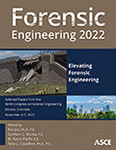Computer Vision and Forensic Investigation
Publication: Forensic Engineering 2022
ABSTRACT
Computer vision, a field which falls under artificial intelligence, is increasingly establishing grounds in many disciplines, as the demand for automated means to solve real world problems gradually grows. Forensic engineering is a discipline that has been moving very closely towards the use of computers as investigation and problem-solving tools. This begins to kindle ideas of how forensic investigation and computer vision can work together to create new approaches and techniques within the field. This paper explores how to use computer vision as a tool to classify the building materials, evaluate the details, and potentially identify distresses of building envelopes using a collection of existing digital images and algorithms that help train the computer to produce efficient and reliable results. Discoveries about computer vision and the complexity of replicating and automating the human visual system encourage deep research on the programming of algorithms to improve and recognize the machine’s ability for the forensic investigation.
Get full access to this article
View all available purchase options and get full access to this chapter.
REFERENCES
Agarap, A. (2018). Deep Learning Using Rectified Linear Units (ReLU). De La Salle University. March 2018.
Bay, H., Ess, A., Tuytelaars, T., and Van Gool, L. (2008). Speeded-Up Robust Features (SURF). Computer Vision and Image Understanding, 110(3), 346–359.
Chaillou, S. (2019). AI + Architecture, Towards a New Approach. Harvard GSD.
Chakraverty, S., et al. (2019). Perceptron Learning Rule. Concepts of Soft Computing, 183–188.
Fountoukidou, T., and Sznitman, R. (2019). Concept-Centric Visual Turing Tests for Method Validation.
Geman, D., Geman, S., Hallonquist, N., and Younes, L. (2015). Visual Turing test for computer vision systems. Proceedings of the National Academy of Sciences. 112 (12): 3618–3623.
Gollapudi, S. (2019). Learn Computer Vision Using OpenCV: with Deep Learning CNNs and RNNs. Apress.
ImageNet. (2007). http://www.image-net.org/.
Janocha, K., and Czarnecki, W. (2017). On Loss Functions for Deep Neural Networks in Classification.
Kardava, I., et al. (July 2018). Training Process Automation for Computer Vision. World Congress on Engineering, vol. 1.
Keras: The Python Deep Learning API. (2015). https://keras.io/.
Kim, H., Ahn, E., Shin, M., and Sim, S. H. (2018). Crack and Non Crack Classification from Concrete Surface Images Using Machine Learning. Structural Health Monitoring, 18(3), 725–738.
Koch, C., et al. (2015). A Review on Computer Vision-Based Defect Detection and Condition Assessment of Concrete and Asphalt Civil Infrastructure. Advanced Engineering Informatics, 29(2), 196–210.
Lowe, D. (2004). Distinctive Image Features from Scale-Invariant Keypoints. International Journal of Computer Vision. 60, 91–110.
Leutenegger, S., Chili, M., and Siegwart, R. (2013). BRISK: Binary Robust Invariant Scalable Keypoints. Autonomous Systems Lab, ETH Zurich.
Matplotlib: Python plotting — Matplotlib 3.3.3 documentation. (2003). https://matplotlib.org/.
NumPy. (1995). https://numpy.org/.
Nwankpa, C., Ljomah, W., Gachagan, A., and Marshall, S. (2018). Activation Functions: Comparison of Trends in Practice and Research for Deep Learning.
OpenCV. (2000-2020). https://opencv.org/.
Paal, S. G., Jeon, J. S., Brilakis, I., and DesRoches, R. (2015). Automated damage index estimation of reinforced concrete columns for post-earthquake evaluations. Journal of Structural Engineering, 141 (9):04014228.
Papert, S. (1996). The Summer Vision Project. Massachusetts Institute of Technology, Project Mac.
Ruder, S. (2017). An Overview of Gradient Descent Optimization Algorithms.
Singh, G., Vedrtnam, A., and Sagar, D. (2013). An Overview of Artificial Intelligence. SBIT Journal of Sciences and Technology, 2(1).1–4.
Spencer, B. F., Hoskere, V., and Narazaki, Y. (2019). Advances in Computer Vision-Based Civil Infrastructure Inspection and Monitoring. Engineering, 5(2), 199–222.
Shan, Q., et al. (2013). The Visual Turing Test for Scene Reconstruction. 2013 International Conference on 3D Vision - 3DV 2013, 2013, pp. 25–32,
Smith, C., et al. (2006). The History of Artificial Intelligence. University of Washington.
Snavely, N., Seitz, S. M., and Szeliski, R. (2006). Photo tourism: Exploring photo collections in 3D. ACM Transactions on Graphics (Proc. SIGGRAPH 2006), 25(3), 835–846.
Song, S., Chaudhuri, K., and Sarwate, A. (2013). Stochastic Gradient Descent with Differently Private Updates. University of California, San Diego.
Teachable Machine. (2017). https://teachablemachine.withgoogle.com/.
TensorFlow. (November 2015). https://www.tensorflow.org/.
Yoshimura, Y., et al. (2019). Deep Learning Architect: Classification for Architectural Design through the Eye of Artificial Intelligence. Lecture Notes in Geoinformation and Cartography Computational Urban Planning and Management for Smart Cities, 249–265.
Yu, L., Yu, Z., and Gong, Y. (2015). An Improved ORB Algorithm of Extracting and Matching Features. International Journal of Signal Processing, 8(5), 117–126.
Zhang, H. (2019). 3D Model Generation on Architectural Plan and Section Training through Machine Learning. Technologies, 7(4) 82;
Information & Authors
Information
Published In
History
Published online: Nov 2, 2022
Authors
Metrics & Citations
Metrics
Citations
Download citation
If you have the appropriate software installed, you can download article citation data to the citation manager of your choice. Simply select your manager software from the list below and click Download.
